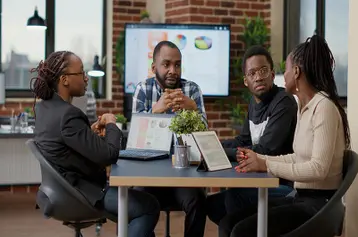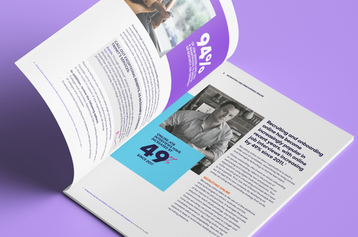What Is Organizational Learning And Why Is It Important?

Table of contents
- 1.What is organizational learning?
- 2.Individual learning
- 3.Group learning
- 4.Organizational learning
- 5.Organizational learning examples
- 6.Inter-organizational learning
- 7.Why is organizational learning important to your company?
- 8.Learning about technology as an example
- 9.How can managers promote organizational learning?
- 10.Create knowledge
- 11.Retain the knowledge
- 12.Transfer the knowledge
- 13.Individuals can transfer knowledge to the organization
With the increasing emphasis on learning and development programs, it’s common to focus on individual learning styles. But what is organizational learning?
Here’s a common situation: Sales have plateaued over the last two years because you’re conducting business the same way you did when you first opened 20 years ago. It’s clear that something’s amiss.
The advanced concepts and processes needed to revitalize your business can be summed up in two words: organizational learning. Here we’ll explore the essence of organizational learning, examples and why it may be essential for your business.
What is organizational learning?
In short, organizational learning can be defined as an organization learning from itself. It’s a buzzword that describes the process of transferring knowledge within an organization. As your business gains experience, it should improve over time.
During this time, you, your team and your organization should be creating a broad base of knowledge, covering any and all topics that could improve how you do business. For example, you should learn more about your ideal customer or create more efficient processes for running your business.
In general, experts in organizational learning theory talk about four different types of knowledge that exist and grow within an organization. They divide them up into the following “communities” of learning:
- Individual
- Group
- Organizational
- Inter-organizational
Individual learning
This is the smallest continuous learning community, consisting of just one person. When an individual employee learns new skills or ideas, productivity and performance generally improve. To maximize the benefit of this individual learning to the organization, the employee who learns the new skill should share it with coworkers. Otherwise, that skill leaves with that employee. If the employee moves on to another job, the new knowledge moves on with them, and the business is stuck in a cycle of retraining.
Individual learning can broaden the common organizational learning definition by way of this synergistic combination of personal and organizational learning.
Group learning
Groups, or teams of employees, can also learn new skills together collectively. When individuals spend the majority of their time collaborating with colleagues, these teams tend to coordinate their efforts in a way that promotes group learning. In group learning, employees develop something that psychologists call “social psychological awareness.” This means that each person perceives themselves as a part of the group, and one group member’s actions affect the entire group. A good example is a team of surgeons. Maybe you’ve seen hospital dramas in which a team of doctors work on a patient together. Everyone contributes ideas and solutions, they work on the surgery together, and they either save or lose the patient as a team.
If one doctor has experience with a particular medical problem, they bring him or her into the surgery so the team can benefit from the expertise.
For many businesses that already encourage collaboration, this can be an excellent learning strategy to ensure a sound knowledge base stays within the organization.
Organizational learning
Wait, isn’t this entire article about organizational learning? Well, yes. Technically, all four of these communities of learning contribute to the organization learning as a whole. But this type gets its own special designation.
A defined organizational learning strategy refers to the organization’s process of gaining new knowledge related to its function and using that knowledge base to adapt to a changing environment and increase efficiency.
The entire organization must engage in organizational learning and adapt to ensure long-term success.
Organizational learning examples
A great example of a company that employs organizational learning is Toyota. According to The Toyota Way by Jeffrey Liker (2004), Toyota views every problem as an opportunity to identify root causes and develop countermeasures.
They use a method called “the five whys,” a form of systems thinking. Here’s how it works:
- There is a puddle of oil on the floor. > Clean up the puddle.
- Why is there a puddle of oil on the floor? Because the machine is leaking oil. > Fix the machine.
- Why is the machine leaking oil? Because the gasket has deteriorated. > Replace the gasket.
- Why has the gasket deteriorated? Because we bought inferior gaskets. > Order different gaskets next time.
- Why did we buy those gaskets? Because we got a good price on them. > Change the purchasing guidelines.
- Why did we choose gaskets based on price rather than quality? Because we evaluate purchasing agents based on short-term cost savings. > Change our evaluation criteria.
Do you see how the business as a whole has learned from this experience? Individual managers might have been the people to ask those “Why”s, but they transferred their new knowledge to their organization by changing policies and procedures based on what they learned.
Inter-organizational learning
This is the broadest type of organizational learning and is the most common learning strategy in franchises or large businesses with multiple locations.
Inter-organizational learning often combines group learning with the more management-led organizational learning process. For example, a franchise might learn how to operate their store by studying the franchise business model.
This learning strategy, sometimes referred to as “collaborative learning,” often offers a competitive advantage by retaining essential and unique company knowledge while ensuring overall operational standards are met.
Why is organizational learning important to your company?
So what’s so important about organizational learning anyway? Companies already do training and professional development. Isn’t that enough?
Sorry, Boss, but no. An organizational learning strategy is necessary if you want a competitive advantage and sustainable growth. The 21st-century business environment is changing rapidly with exciting new technologies that have transformed the way people operate.
Many people now rely on digital assistance for shopping, driving, cooking, learning and communication. To remain appealing to customers, businesses must adapt to these changing behaviors.
The concept of organizational change isn’t a fad; it’s an essential strategy for growth, retention and customer experience. Consider the benefits of maintaining organizational knowledge:
- Upskilling often leads to promotions for employees, which leads to higher retention — and fewer hiring costs.
- Opportunities to learn and grow rank are crucial factors for improving organizational culture.
- Executives are concerned that employees do not have the right skills.
Learning about technology as an example
Consider how technology and norms around using it have rapidly transformed common business practices.t’s easy to see why organizational knowledge and continuous learning are critical.
Look at social media, for example. There was a time when a business didn’t need an online presence at all. Then, having a simple website and email address was considered cutting-edge. Later, businesses needed social media accounts on platforms like Facebook and Twitter.
Next, it was important to share updates with your followers multiple times a day. Eventually, it wasn’t enough to tweet updates about your business; you had to ask engaging, personal questions of your followers and share your own stories as well.
The bottom line is your organization’s leadership must continually learn to adapt to a changing environment. It’s not enough for individuals within your organization to learn new skills; the organization as a whole needs to learn and adapt for long-term success.
How can managers promote organizational learning?
There are a number of steps managers and business leaders can take to promote organizational learning as one of their key organizational goals.
Create knowledge
The first step toward establishing a strategic learning process is knowledge creation. Leadership should constantly seek to uncover new knowledge about their business, customers and environment.
This can be achieved through surveys, performing market analyses, networking with colleagues in their industry and competitor research.
Tapping into human relations is important — don’t just focus on hard numbers. Ask open-ended questions to employees, consultants and customers to create a well-rounded knowledge base.
Retain the knowledge
Once human resources or managers have created or obtained the knowledge, they need a system for retaining it within the organization.
It should be recorded or stored in a place where it will be accessible to other employees in the future. Many companies achieve this goal by using intranet systems.(The organizational learning gurus would call these “knowledge management systems.”)
Transfer the knowledge
Finally, the new organizational knowledge must be transferred from the individual communities to the entire organizational community.
Some methods for transferring information are simple, like conducting training or writing articles to share online. But it’s important to also use the insights to inform your business processes.
Remember our Toyota example above? The managers who solved the problem of the leaky oil gasket didn’t just find out why the gasket was leaking. They used that information to change how they purchase gaskets in the future.
Individuals can transfer knowledge to the organization
By using the new knowledge base to inform decision-making, design efficiency routines and change processes, managers can transfer their individual knowledge to the organization as a whole.
Think of organizational learning as the comprehensive knowledge-sharing structure within the organization. Individual managers or groups of employees are all learners and can become assets. They share that information with the business, which then uses it to change its practices.
This is how businesses thrive in a changing environment and achieve long-term success.

TriNet Team
Table of contents
- 1.What is organizational learning?
- 2.Individual learning
- 3.Group learning
- 4.Organizational learning
- 5.Organizational learning examples
- 6.Inter-organizational learning
- 7.Why is organizational learning important to your company?
- 8.Learning about technology as an example
- 9.How can managers promote organizational learning?
- 10.Create knowledge
- 11.Retain the knowledge
- 12.Transfer the knowledge
- 13.Individuals can transfer knowledge to the organization





